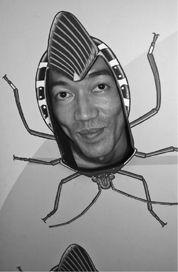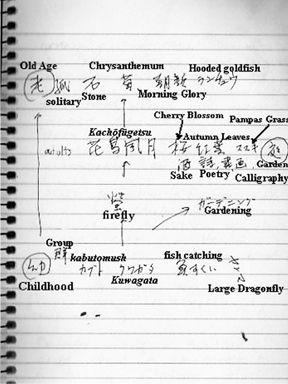Insectopedia (56 page)


It was in the 1980s that Mushi-sha began selling live animals. Back then, Iijima told us, it was
ookuwagata
, the large Japanese stag beetles that Kuwachan breeds, that were in demand. They had become difficult to find in urban areas but were still easily available in the countryside, and it was commonplace there for children to keep them as pets. Some stag beetles lived in the mountains, mostly in Osaka, Saga, and Yamanashi Prefectures. But most made their homes close to villages, in
satoyama
, the patches of forest that people managed for mushrooms, edible plants, timber, compost, and charcoal, among other useful goods.
5
Over time, the burned and coppiced charcoal trees came to look like dark knobs, Iijima said, and it was in the holes in those trees that the
kuwagata
lived.
Kuwagata
were at home in
satoyama
, he told us, because they like being close to humans.
Iijima explained that the
kuwagata
and
kabutomushi
boom of the 1980s was stimulated by an increased supply of insects to the cities at a time of high disposable income, before the collapse of the bubble economy. Recognizing the signs of urban demand and developing more effective trapping techniques, villagers brought beetles to Tokyo from
the countryside, selling them to department stores and pet shops. Some urban enthusiasts went the other way, deepening their hobby by traveling to the country to catch beetles themselves (and plant the seeds of the informal network of rural inns that now advertise their services as beetle-hunting bases). Others became interested in breeding beetles. Both larvae and adult beetles were available to buy and hobbyists started investing their time in developing techniques for raising bigger animals. This shift to breeding was a significant innovation, said Iijima. Even though back then no one managed to raise beetles as large as the ones found in
satoyama
or the mountains, many people took up the challenge. Not surprisingly, it was in these years of growth—both in the economy and in the passion for beetles—that most of the country’s insectaria opened.
The real estate boom that swept Japan in those years transformed the countryside. As demand for charcoal fell and brick replaced timber in home construction, the maintenance of managed forest declined; as housing developments expanded,
satoyama
retreated. By the early 1990s, it was challenging even for local people to find large stag beetles in the wild. For most visitors from the city, it was far harder. Prices of wild insects soared. Yet by this point there was a thriving subculture of beetle breeders throughout the country—amateur experts like Kuwachan who succeeded in mapping the life cycles and habits of the popular species and in developing and circulating sophisticated yet easily replicated techniques for raising large animals from eggs.
6
It was a complex story, but Iijima Kazuhiko was a patient narrator. Like everyone we met in Mushi-sha, he was young, friendly, knowledgeable about all aspects of the business, and serious about insects. We were standing at the back of the store, in front of a large, indexed cabinet full of high-quality specimens from around the world and beside tall stacks of
Gekkan-mushi
,
Be-kuwa!, Kuwagata Magazine
, and other glossy and expensive specialist publications. On all sides were shelves of Perspex containers holding male and female
kuwagata
and
kabutomushi
of varying sizes and prices. From behind the counter Iijima pulled out a large foam-lined case. Inside—huge, soft bodied, and defenseless, motionless on its back—was a metamorphosed beetle pupa. It was a male
Dynastes hercules
, the largest of the rhinoceros beetles, recorded as growing to just
over seven inches, and worth well over U.S. $1,000. A small group of admiring customers gathered to look.
In the 1990s, continued Iijima after returning the case, there were three types of enthusiasts. There were those who went to the mountains to hunt beetles; they were working in the tradition of the old-time collectors, but it was, of course, much harder now for them to find insects. Then there were those, usually schoolboys, who purchased inexpensive live beetles and kept them as pets. Finally, there were those who bought larvae or adult pairs and bred them as a hobby or for sale, often trying to set the record for the largest individual of the particular species. Indeed, he said, by that point it was much easier to breed
kuwagata
and
kabutomushi
than to catch them.

Despite (and because of) the decline in wild beetles and the destruction of their habitat, beetle keeping and raising was thriving. Mushi-sha was at the center of a lively entrepreneurial culture serving both a new generation of insect fans and an aging but rejuvenated cadre of experts. When CJ and I met Okumoto Daizaburo a few days later, he readily took on the task of explaining why it was that all this insect love existed here in Japan. Professor Okumoto used arguments we had heard from other insect people, arguments that described a uniquely caring Japanese relationship with nature and drew on
nihonjinron
, the persistent ideology of Japanese exceptionalism, which, like many nationalisms, is based on a belief in a unified national population possessing a unique transhistorical essence.
7
The beetle boom, Okumoto said, was just one piece of a special national affinity for nature. He talked about the high species endemism of the country’s island ecosytem and how this unusual variety of animals and plants, and of insects in particular, produced an exceptional sensitivity among the human population. He talked about earthquakes and typhoons and how these too-familiar events created a visceral awareness of the surrounding environment. He talked about the role of animism, Shintoism, and Buddhism in creating an intimate environmental ethic
that still pervades Japanese daily life despite the decline in overt religious practice. He talked about the audiologist Tsunoda Tadanobu’s controversial research in the 1970s, which suggested that Japanese brains are singularly attuned to natural sounds, including cricket song.
8
He talked about the extraordinary expressions of high cultural attachment to insects in literature and painting. And borrowing my notebook, he drew a diagram—a schematic representation of an ideal Japanese life, which CJ later annotated for me.

It was an ideal man’s ideal life, timeless but classical, the ideal life of a scholar or nobleman. Professor Okumoto offered it as a sketch of enduring national tradition, an elegantly simple capsule of a complex ideology. He depicted three ages of man in an arc from youth to dotage, from carefree friends chasing dragonflies and goldfish to the sunset years of meditative solitude; he described how each stage has objects and activities
appropriate to the correct forms of self-cultivation (from
kabutomushi
and fireflies through
ka-cho-fu-getsu—
flower-bird-wind-moon, the contemplation of the subtleties of nature—to the care of chrysanthemums); and he explained that these simple practices can (even in such an elementary version) create a meaningful Japanese life.
As the professor talked, it struck me and CJ that these forms of play, culture, and contemplation were an aspiration, a promise of contentment and fulfillment that tied together many of the insect people we had met. His sketch reminded us of the yearning for emotional purity at the heart of Kuwachan’s insect poems. It was a framing for the stories of insect love as a formative stage in the making of a whole person. Antithetical to urbanized, bureaucratized modern life, unattainable by most people even in childhood, as a model for a form of life, its role was largely critique. It was part of that family of utopian insect stories that included Miyazaki’s hippie town, Tezuka’s secret jungle, Kuwachan’s poetry, and those hopeful weekends of
kazoku service.
And, like those stories, it helped explain some of the emotional burden that Japanese insects were asked to assume and some of the desires that they seemed so readily to bear.
Before 1999, most Japanese insect lovers knew foreign stag and rhinoceros beetles through magazines, television, and museums. These animals were often bigger and more spectacular than the local species; many had longer horns and antlers, larger bodies, and showier coloring. But under the Plant Protection Act of 1950, it was illegal for private collectors to bring them into Japan. There was, however, no penalty for owning or selling restricted animals once they were in the country, and that anomaly enabled a lively black market, extravagant prices, and a profitable smuggling industry reputedly controlled by the
yakuza.
Still, the number of animals involved was relatively small and the well-heeled collectors involved were a select set.
The Plant Protection Act compiles lists of animals considered “detrimental” to native plants and agriculture. However, it has an unusual pre
cautionary protocol: all species are classed as detrimental until authorized for entry at a plant protection station. In 1999, under pressure from collectors eager to know which beetles were permitted, the Ministry of Agriculture, Forestry, and Fisheries published a list on its website of 485 stag beetles and 53 rhinoceros beetles considered “nondetrimental.”
9
Within two years, 900,000 live
kuwagata
and
kabutomushi
had been imported.
10
Even so, in succeeding years the ministry added more species to its list until, by 2003, 505 species of stag beetle had been authorized out of a worldwide total of around 1,200 described species. As the entomologists Kouichi Goka, Hiroshi Kojima, and Kimiko Okabe commented drily, “The habitat maintaining the highest biodiversity of stag beetles is Japanese pet shops.”
11
In 2004, they estimated the value of the import trade at ¥10 billion (about U.S.$100 million). Large individuals of desirable species were selling in Tokyo for upward of U.S.$3,300.
12
The scale of the growth in live-insect imports was completely unexpected. Iijima Kazuhiko told us that the Ministry of Agriculture, Forestry, and Fisheries ignored warnings from the Ministry of the Environment but, nonetheless, the government had no idea what it was unleashing. However, he added, there were high-profile precedents that should have been cause for hesitation: animals such as the black bass, the raccoon, the small Indian mongoose, and the European bumblebee
Bombus terrestris
, which are infamous in Japan for adapting too successfully to their new environment. But when it came to beetles, policy makers and scientists were confident that foreign
kuwagata
and
kabutomushi
, most of which come from subtropical and tropical Southeast Asia and Central and South America, would be unable to survive the harsh Japanese winter. Only later did they realize that many of those animals’ home ranges were at high altitudes in cooler temperatures.
13
The import boom crested quickly. By 2001, the number of beetles entering Japan had fallen significantly from its height, and as the supply increased, the prices for all but the rarest (and largest) slumped too.
14
But even with reduced quantities, it was evident that the boom had radically expanded the breadth of the trade. New insect shops had opened their doors, and existing pet stores had retooled. Large department stores were carrying imported species. For a while, live beetles were available from vending machines. All kinds of products that made raising
and caring for the animals simpler and more appealing were brought to the market (individual servings of food in jelly form, “fungus jars” of habitat medium, deodorizing powders, cute carrying cases). Most significantly, an unknown but anecdotally vast number of people had taken up beetle breeding. Between 1997 and 2001, seven glossy specialist magazines were founded that offered advice to breeders, ran competitions, featured stories of intrepid collectors, shaped a sense of beetle aesthetics, and nurtured the emerging communities of enthusiasts.
15
